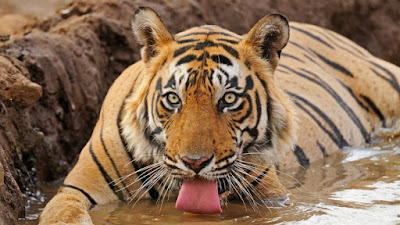Tigers
Panthera tigris
Listing Date: 06/02/1970 Listing : Endangered
https://goo.gl/images/4oh5VM
Description and Ecology of Tigers
The largest of the Asian big cats is the tiger or also known as the Panthera Tigris.There are about 4,000 of these large mammals left roaming the forests, grasslands, and savannas around tropical Asia. They weigh around 220-600 lbs and can extend up to 6 feet long, and sometimes larger. With such large body masses, these carnivorous creatures' diet consists of deer, wild pig, fish, birds, rodents, and more. Tigers consume an abundance of meals a day and require a lot of land in order to maintain a healthy lifestyle. Although, Habitat loss makes it very difficult for these standards to be met. It is possible for these animals to live up to 20 years, most barely make it passed year 2 with the pressures from poaching and environmental destruction.
Geographic and Population Changes
https://goo.gl/images/SVXqLb
Tigers are known as "solitary creatures" and have a wide roaming area of about 4,000 miles in range typically in the tropical forests near Asia,but few other savanna and grassland locations as well. Each tiger needs a large territory to hunt and run freely. They mark their territories with claw marks and are very territorial. Due to agriculture and other human activities these animals are being forced to range in only small areas of land. According to worldwildlife.org, tigers have lost 93% of their historical range to industrialization and human activity. The limiting of space available for these mammals makes it nearly impossible to get a sufficient amount of meals a year and eventually a higher risk of inbreeding. As tiger populations continue to decrease, they potentially become more vulnerable to poaching as they roam alone throughout the land. There is estimated to be about 4,000 tigers left and the numbers continue to decrease every year. Cause of Listing and Main threats
Tiger's face numerous threats and have become listed highly endangered on the IUCN red list. Their lifestyle crucially depends on lots of extended land and prey in order to prosper. Due to human activity, tiger's are losing their habitat in the competition with humans for space. The tearing down of forests for agriculture, roads, industrial needs, and timber has shrunk about 93% of the tiger populations historical range.Sumatran Tiger and Bulldozer Caught on Camera
Poaching is also a serious threat Tigers face causing them to be endangered. Almost every part of their body is sold through the black market trade and illegal wildlife markets. Many traditional cultures use their body parts for medicines, remedies, and especially their pelts. Many poachers kill mothers, due to their largeness ,which highly affects the reproduction rate of tigers. Most cubs can't survive without their mother and most often die very young.
A women named Belinda Wright sorting through tiger bones found near the Kanha Tiger Reserve in India in 1995. (Photo from the Wildlife Protection Society of India) https://voices.nationalgeographic.org/2014/02/12/illegal-tiger-trade-why-tigers-are-walking-gold/
Description of Recovery Plan
It is very difficult to protect this species due to their location having limited supplies and resources. Although hope is high for this species due to their ability to retain much of their genetic viability. The primary goal to recover the tiger population is to enforce and created laws towards the smuggling, poaching, and selling of such animals. It is also beneficial to improve the protection and guarding of the tigers in their habitats. Furthermore, the land in which they live also needs full protection against industrial surroundings and commercial development growing in society.
Here are the steps to take :
1. Work towards strengthening legislation and institutions directed towards crime against tigers.
2. Set up patrol systems for poachers surrounding tiger habitats and their prey.
3.Work on conserving and preserving the forests, savannas, and wetlands but reducing our carbon footprint and commercial expanding.
3.Work on conserving and preserving the forests, savannas, and wetlands but reducing our carbon footprint and commercial expanding.
WHAT CAN YOU DO?
It is often difficult to directly stop poachers or instantly make a difference, but there are other things that can be done as well. By informing others on the endangerment of tigers, they can be more aware of the things they purchase or the activities they engage in that can potentially harm the tiger population. Research on how tigers interact and reproduce would also be beneficial in learning more about protecting this species. There are also numerous foundations and volunteer programs that accept help and donations for the cause.
Other Resources
1. https://gifts.worldwildlife.org/gift-center/gifts/Species-Adoptions/Tiger.aspx?sc=AWY1800OQ18688A01324RX&gclid=Cj0KCQiAlpDQBRDmARIsAAW6-DPVbKKMGEyryOzPepAP8S-eZUWAUxiakQFAap6RV6qgd0fDyb0WVdIaAtkhEALw_wcB
2. Donations accepted at world wild life. org
3. www.savethetigerfund.org
Bibliography
1. Defenders of Wild Life. org http://www.defenders.org/tiger/threats
2. National Geographic "Why tigers are walking Gold"https://voices.nationalgeographic.org/2014/02/12/illegal-tiger-trade-why-tigers-are-walking-gold/
3. Worldwildlife.org https://www.worldwildlife.org/species/tiger






I found it very surprising how large their roaming area is. It makes sense that they are endangered since the majority of their habitat has been destroyed. - Sophie Richnak
ReplyDeleteI had no idea that Tigers weren't rarely pass the age of 2 anymore! That is terrible! Of course there is no wonder as to why, especially with the females being hunted and a staggering 93% of their habitat destroyed!
ReplyDeleteI like how how the recovery plan talks not only on protecting the tigers, but on protecting their prey. I feel like that aspect can be easily overlooked, despite its importance. - Regina Seiler
I knew that tigers were big, but 600 lbs, that's huge. I also never really thought about poaching for anything other than the pelts, but apparently you can sell all parts of them.
ReplyDelete-Christine Peters
DeleteI never realized how massive Tigers actually are. It's upsetting to know that due to human impact, their potential life span has dropped from 20 to 2. I can't believe they've lost 93% of their historic range! It's insane to me that people feel the need to poach these beautiful creatures, and that they even consider it an accomplishment.
ReplyDelete-Bella Ramirez